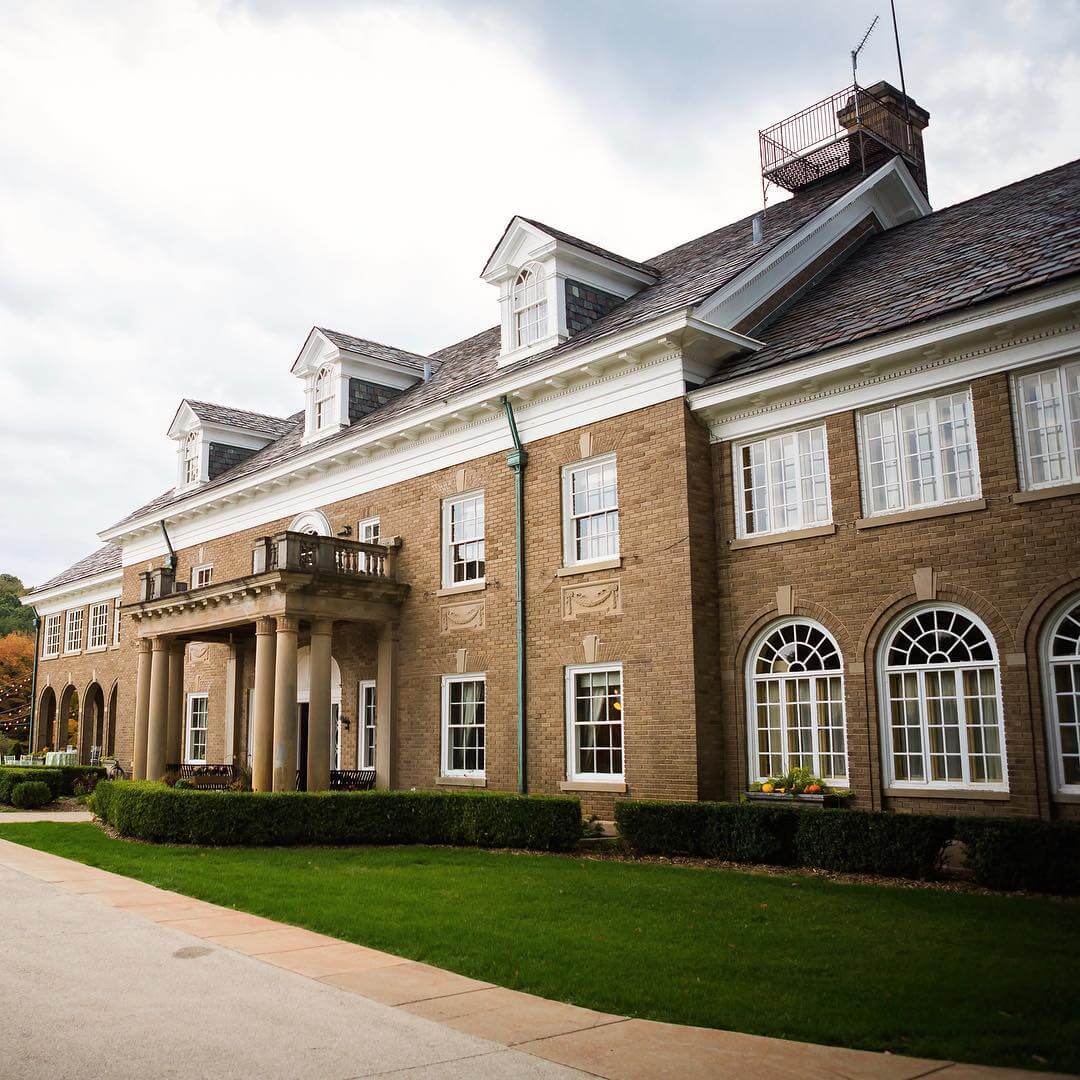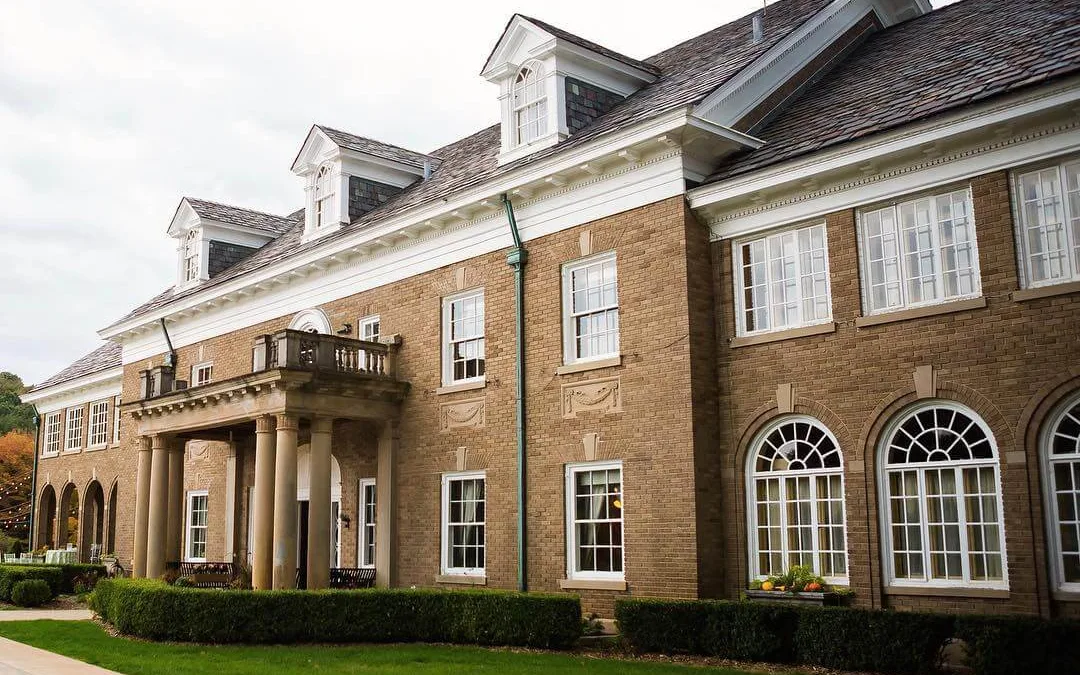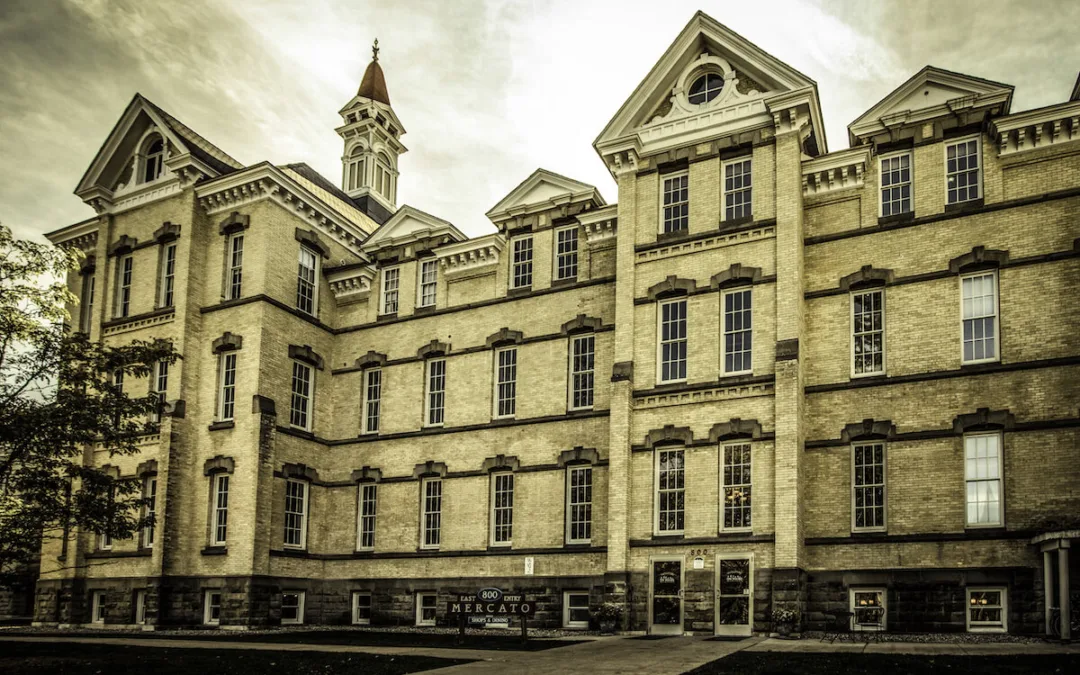
Photo courtesy of The Felt Estate and Shore Acres Farm via Facebook
From fallen soldiers and heartbroken lovers to witches’ curses and unexplained creatures, here are the best spooky stories in Michigan.
MICHIGAN—If you’re a devotee of all things creepy, you can certainly find plenty of great fictional horror stories, but it’s a little creepier knowing which ones are based in reality—and right in your backyard.
In 2020, Forbes named Michigan the fourth most haunted state in America, thanks to its wide variety of creepy stories. There are lots of fairly well-known ghost stories in the Mitten, like the many that come from Mackinac Island alone. But you don’t have to travel to the Straits of Mackinac to find a creepy story—there’s plenty around Michigan in places you may be more familiar with.
We’ve rounded up a few of our favorite creepy stories involving ghosts, haunts, and urban legends, all of which might just make you sleep with the light on tonight. Warning: Tales of violence, some of which are quite gruesome, are to follow.
Torch Lake Sea Panther
Torch Lake, Antrim County

Photo courtesy of YMCA Hayo-Went-Ha Camps via Facebook
Everyone’s heard of the Loch Ness Monster, thought to reside in its namesake lake in the Scottish Highlands, but few people know that Michigan has its own underwater cryptid. Torch Lake is Michigan’s second-largest inland lake, with teal-blue, tropical waters that invite fishing expeditions, summer recreation, and celebrity vacation homes. But despite the popularity of its waters, there may be something more dangerous lurking beneath this family-friendly water attraction.
The Legend: The Torch Lake Monster, sometimes described as a Sea Panther, is only ever seen at night. The reported sightings go as far back as the 1960s. According to stories, the monster has one brown eye and one blue eye and is often described as coated in green goo. Sometimes, it’s been described as having a lizard’s body and a cat’s head—hence the Sea Panther moniker. The creature supposedly lurks in the deepest depths of Torch Lake and only rises to the surface at night, preying upon those who venture out into the water after dark. Its victims are often swimming, boating, or fishing somewhere they shouldn’t be, but perhaps the most prominent targets are campers—especially those from the nearby YMCA Camp Hayo-Went-Ha. Whether the monster devours the victims or simply chases them away from its lair varies depending on the tale.
The Reality: Torch Lake’s waters are quite deep, going down 285 feet in some spots. Large fish such as the muskellunge, which can be as big as 50 pounds, call the waters home. So it’s plausible that something could be lurking beneath the depths, but it is believed that the origin of the Torch Lake Sea Panther story comes from Dave Foley, who worked as a counselor at Hayo-Went-Ha during the 1960s and ’70s.
Hell’s Bridge
10180 Friske Drive NE, Rockford
Deep in the western Michigan woods, about 20 minutes north of Grand Rapids, rests a small steel footbridge traversing Cedar Creek. The bridge seems unassuming—barely able to hold even one person—but according to folklore, Hell’s Bridge, as it’s known, has a disturbing history steeped in infernal influences that inspire terror.
The Legend: In either the mid-to-late 1800s, so the legend goes, an old man named Elias Friske lived near Rogue River. In some versions of the story, Friske was a preacher. One day, the local townsfolk asked Friske to watch some children so they could search for some other kids who had gone missing. Friske, who didn’t seem able-bodied enough to search for the children, agreed, then tied the children by the waist with rope, ostensibly so as not to lose any more of them.
As the legend goes, Friske marched the tethered children into the woods, taking them down to Rogue River, around where the footbridge had recently been built. As they arrived, they made a gruesome discovery—a horrifying stench led the children to the decomposing bodies of the missing children. The children screamed and cried, but Friske knew no one was coming to save them. He murdered every last child, one by one, as he had the previous ones. From there, he threw the bodies into Rogue River and ran deeper into the woods.
The townspeople eventually came looking for Friske and the children. They discovered the bodies of the murdered children beneath the bridge. They tracked Elias Friske until they were able to overtake him. “The devil made me do it,” was all he had to say in his defense.
So the story goes, the townspeople hung Friske with the very rope he had used to tether the children, giving him a chilling end as his body descended into the swelling waters to be carried away by the current.
The spirits of Elias Friske, the murdered children, and the demonic entities that called for the killing are all suspected to haunt the location. Visitors who float down the Rogue River in inner tubes have claimed to feel hands grabbing at their feet, trying to pull them into the water. Explorers of the bridge itself have claimed to hear children laughing and screaming as well as ghostly footsteps across the bridge. Sometimes, the laughter becomes dark and demonic, especially around midnight.
Some visitors have claimed to witness glowing red eyes either moving through the woods or glaring back at them from an entity who manifests upon the bridge. Supposedly, if you gaze into the water too long, you can even see the dead children’s faces.
The Reality: Though the US Census can trace a Friske family to the Algoma area around 1910, there is no record of a man named Elias Friske. The name may have been inspired by Friskie Road, where you can access the trail that leads to Hell’s Bridge. Additionally, it is unknown where the name Rogue River came from, as the waterway is now called Cedar Creek.
Still, visitors to the Hell’s Bridge area have reported strange and unexplained phenomena that may have a paranormal origin. Orbs and unexplained noises are the most commonly cited experiences beyond those noted above.
The Saugatuck Melonheads and the Felt Mansion
6597 138th Ave., Holland
Built in 1928, the Dorr E. Felt Mansion in Holland may seem like any other historic home, but this beautiful Classical Revival house has a connection to one of Michigan’s strangest urban legends: the Saugatuck Melonheads. Stories about the Melonheads are prevalent in western Michigan and beyond, to the point that even Ohio and Connecticut have their own versions of the story.
The Legend: For decades, the Allegan Forest and Saugatuck Dunes State Park area has been said to be home to small, feral humanoids with large, bulbous heads. In some cases, they have been spotted in wooded areas throughout Ottawa County. These are the Saugatuck Melonheads, sometimes called “wobbleheads.”
As the legend goes, a hospital in the Saugatuck area had been treating children with hydrocephalus, a condition characterized by fluid build-up in the brain. In other versions of the story, these were children kept at the Junction Insane Asylum to be experimented on by a doctor there—sometimes physically and emotionally abusing them, as well. Depending on the story, the doctor released the Melonheads into the forests or, in the darker versions, the children rebelled against the doctor, killed him, and consumed his flesh. In yet other versions, the Melonheads were simply released after the facility was decommissioned.
Whatever the reason for their escape, so the legends go, the Melonheads have been infesting the surrounding forest areas ever since. Nearby the Felt Mansion, there is a small building that is said to be the remains of Junction Insane Asylum. Late-night visitors have reported seeing curtains moving in the old building and strange noises emanating from the building. But around the entire area, visitors have reported feeling watched. They’ve also told of hearing footsteps and heavy breathing or seeing shadowy silhouettes.
Supposedly, there’s an underground series of tunnels and caves where the Melonheads live. Children especially were warned not to go into the forests late at night, lest they fall victim to the Melonheads who sought to eat them. Visitors are advised to steer clear of the leering red eyes of the Melonheads.
The Reality: The Allegan County Historical Society is adamant that no asylum ever existed in the area. Instead, the old building referenced as the old asylum is actually a remnant of the Dunes Correctional Facility.
The story of the Melonheads is contested by the fact that the Felt Mansion had formerly housed the Saint Augustine Seminary, a Catholic prep school for men. The particularly smart students at the seminary were called “melon heads,” similar to how the term egghead has been commonly used as a bullying term. This may have been the origin of the term Melonheads—not feral humanoids, just a nickname for a group of smart people that existed in Saugatuck’s history.
Despite this, many a Michigander have sworn the Melonheads are real. There have been many eyewitness accounts of unexplained phenomena going on around the Allegan Forest and inside the Felt Mansion. Employees and visitors of the mansion have reported possible paranormal activity such as furniture and other objects moving without explanation, and doors and windows opening and closing on their own. People have reported seeing shadow figures and apparitions, or just in general feeling a strange presence or like they were being watched.
The Ghost Town of Pere Cheney
Beaver Creek Township, Crawford County
Considering the state’s former status as a destination for both the lumber industry and copper industry, there are a handful of abandoned towns in Michigan that are considered ghost towns. Pere Cheney, a former lumber town just a stone’s throw from the northern Michigan town of Grayling, gives the ghost town epithet new meaning.
Pere Cheney was abandoned more than a century ago, in 1918, but it’s still a paranormal hot spot, to the point it’s often called “The Most Haunted Town in Michigan.” Though the Pere Cheney Cemetery, which once held 90 graves, is often cited as the most haunted location, the ghost stories persist throughout the town. It would seem the entire town might have a curse on it that persists to this day.
The Legend: According to legend, Pere Cheney’s demise was the result of a witch’s curse. Soon after the town’s founding in 1874, the approximately 1,500 residents of Pere Cheney learned there was a witch among them. In some versions of the story, the “witch” is simply a woman who had a child out of wedlock. The townspeople either banished the witch to live in the woods or chased her out as an angry mob. Some versions of the story claim the witch hid in the woods with her child, after which he became sick and died. Thereafter, the witch was caught and awaited her execution.
In all versions of the story, the witch cursed the town with pestilence and sorrow. In many cases, this was before her death at the hands of the townspeople. In some, she was hanged at the big oak tree in the cemetery and buried beneath it.
The witch’s curse came due when the town of Pere Cheney experienced bouts with infectious diseases, including diphtheria, smallpox, and scarlet fever. Within a couple decades, the town of Pere Cheney was no more.
To this day, the witch is still said to haunt the area, with some visitors claiming to have seen the ghost of the scorned woman haunting the area where she was executed. Visitors also report seeing shadowy figures throughout the town, hearing disembodied laughter and voices, or even finding tiny handprints upon their vehicles.
The Reality: Diphtheria did wipe out most of the Pere Cheney population in 1893, with subsequent outbreaks and fires obliterating what was left of the town. Whether or not there was really a Pere Cheney witch, the town is still a hotbed of paranormal activity. Many visitors have publicly reported their stories about experiencing cold spots, disembodied voices, apparitions, and even ghost trains.
The ruins of Pere Cheney have been repeatedly vandalized and ransacked over the years, to the point that the cemetery is about all that’s left.
The Landmark Inn
230 N. Front St., Marquette

Photo courtesy of Landmark Inn via Facebook
One of the oldest and most distinguished hotels in the Upper Peninsula is also a hotel that The Shining director Stanley Kubrick would love. The Landmark Inn opened in 1930 as the Northland Hotel and little has changed since then. It was host to a variety of established guests, including Louis Armstrong, Amelia Earhart, and The Rolling Stones.
Not only is the posh decor and opulence reminiscent of the famous Overlook Hotel, but also the Landmark Inn has its fair share of ghost stories. In fact, it’s reported to be one of the most haunted hotels in the country.
The Legend: Though there are many ghost stories at the Landmark Inn, the most popular one involves the sixth-floor Lilac Room and its would-be patron spirit, the Lilac Lady—sometimes called the Librarian.
As the story goes, the Librarian was a spinster who had fallen in love with a crewman. They carried on their love affair in the Lilac Room. The couple was betrothed and planned to marry after the crewman’s final cruise. He set sail on Lake Superior but never returned. Though the Lady was stalwart in her loyalty and waited for her beloved, the missing mariner was declared dead after a long search. In a fit of heartbroken sorrow, the Librarian either died of a broken heart or deliberately ended her own life. Now, she haunts the room thought to be where she spent her final days.
The Lilac Lady is said to wear a floral gown, waiting in her room for her beloved to return. She’s often observable from the window, looking out onto Lake Superior. Supposedly, hotel employees frequently receive phone calls directly from the Lilac Room, even if the room is vacant. She also is said to roam the halls.
The Reality: Though it’s unknown if the story of the Lilac Lady is true, there’s definitely something unexplained going on in the hotel. Guests have reported disembodied voices, strange sounds, flickering lights, cold spots, and the feeling of being watched. Some witnesses have also placed the apparition of a young woman in the Lilac Room or the adjacent hallways.
Snake Goddess of Belle Isle
Belle Isle Park, 7200 Jefferson Ave., Detroit

Photo courtesy of Belle Isle Park – Michigan via Facebook
Ghost story connoisseurs are quite familiar with stories of the “Woman in White” or “Lady in White.” These spectral and feminine figures are usually the tragic victims of love stories gone wrong, having lost their one true love through some tragedy. In medieval legends, the “White Lady” was often considered an ill omen, seen either shortly before or after a family member’s death.
But Detroit’s 982-acre island park Belle Isle has its own legend of a woman in white that has basis in local history and Indigenous folklore.
The Legend: According to legend, the woman in white on Belle Isle, also known as the Snake Goddess, was the daughter of an Indigenous chief from the Ottawa tribe. Chief Sleeping Bear’s daughter was said to be so beautiful that he had to hide her in the Detroit River within a blanket-covered canoe.
As the legend goes, the chief’s daughter was so beautiful that even the wind desired to gaze upon her beauty. When the wind attempted to move the blanket to admire her, it unwittingly pushed the canoe down the river. This led to the daughter’s tragic kidnapping. When Chief Sleeping Bear recovered her, he swore to keep her safe by placing her on Belle Isle instead.
Through a ritual meant to keep the daughter safe, Chief Sleeping Bear asked the Great Spirits to protect his daughter forever. The spirits responded by making the daughter immortal and, additionally, populating Belle Isle with snakes. Ever since, the daughter, now known as the Snake Goddess, has been witnessed on Belle Isle beckoning visitors into the woods. Though she normally appears as an otherworldly lady in white, she also takes the form of a white doe who escapes into the woods when spotted and approached by visitors. Ultimately, she doesn’t seem to be a violent or vengeful spirit, but a sad and mournful one who never got to live her own life.
The Snake Goddess usually appears near bridges or swamps, especially the bridge on Tanglewood Drive. People hiking on foot often see her after stopping at a bridge. Motorists encounter her by parking near a bridge and turning off their motor. Other legends claim motorists must honk their horn three times to get her attention.
The Reality: The Ottawa Indigenous tribe and the Snake Goddess tale definitely have historic roots in the Belle Isle area. The Ottawa settled in the area around 1701, when Detroit was Fort Detroit. They lived in the area until the forced removal of Native American groups through the Treaty of Detroit, signed in 1807, and the Indian Removal Act, signed in 1830.
Additionally, Belle Isle was formerly known as Rattlesnake Island, known for the large population of water snakes. Whether or not the Snake Goddess is real or just an urban legend, Belle Isle definitely has its creep factor.
Findlay Cemetery and the Ada Witch
2 Mile Road NE, Ada
The Ada Witch is another legend that draws upon the “woman in white” archetype. The apparition is a local legend in western Michigan, primarily concentrated to Findlay Cemetery but also associated with the surrounding area and roads.
The Legend: The story of the Ada Witch starts off either in the 1800s or 1900s. A woman was allegedly committing infidelity, meeting up with her secret lover at night. But one night, her husband suspected that she was up to no good and followed her. Some versions of the story claim that he followed her to Seidman Park. The jilted husband discovered his wife in the arms of her adulterous lover and became enraged, attacking the couple. As the story goes, the wife was the first to perish, leaving the two men to continue in their violent struggle until they eventually died from the wounds they gave each other.
One website dedicated to the Ada Witch legend claims she died in 1868, though there is no way to verify this information. As the story goes, the slain wife still haunts the area to this day. She has been spotted wandering along Honey Creek Road, Egypt Valley Avenue, and Bailey Drive.
Though the combatants have supposedly perished, her husband and lover still continue their ghostly fight, according to legend. Visitors have heard sounds of a fight, yelling, or sobbing, though there were never any people there. Other times, visitors have reported feeling a presence or a tap on the shoulder with no discernible cause.
In the middle of the Findlay Cemetery is a broken gravestone that is reported to belong to the Ada Witch, marking her final resting place. Until its restoration, the tombstone had its top half missing, with the bottom half held up by two wooden posts. Visitors often leave coins, trinkets, and candles at the site to honor the Ada Witch.
The Reality: The legend of the Ada Witch is one of a few urban legends with no evidence of a real-life event to back it up. In 2013, author Nicole Bray was doing research for her book Ghosts of Grand Rapids when she discovered who the broken grave belonged to. The woman’s name was Sarah McMillan, but she died of typhoid fever in 1870 at the age of 29, not murder. Bray orchestrated the restoration of the gravesite with a donation of a new headstone, but the connection to the Ada Witch may still persist, as orb photos and other unusual phenomena are frequently captured or reported in the cemetery.
River Raisin Battlefield Ghosts
333 N. Dixie Highway, Monroe

Photo courtesy of River Raisin National Battlefield Park via Facebook
The River Raisin National Battlefield Park is both the smallest and the newest of Michigan’s five national parks. But despite its relative newness, it holds a lot of haunted history. The park recognizes the infamous Battle of the River Raisin, the greatest defeat for the United States during the War of 1812, which took place mostly in Michigan. Some places associated with the war have also become associated with ghosts.
The Legend: Though it has been over a century since the Battle of the River Raisin, the ghosts of the fallen soldiers are reported to still wander about the battlefield. Disembodied cries of pain and agony as well as the sounds of war conflict can still be heard in the field. Ghostly apparitions of soldiers have appeared and often been photographed in the field, in doorways, and in windows. Another common apparition is a young girl in a white dress, thought to be a girl searching for her deceased beloved.
The activity is said to have attracted a poltergeist, usually a meddlesome and bothersome spirit, who haunts the Visitor’s Center. When the center was a house, the residents reported paranormal activity, which has since been additionally experienced by staff there. The poltergeist creates a lot of noise, which can sound like someone running down the hall and down stairs, slamming against walls, and crashing into things.
Visitors have also reported feeling great sorrow in the location—the River Raisin is clearly not a spiritually peaceful place.
The Reality: Over 500 American soldiers were killed at the River Raisin and scattered human remains have been recovered as recently as 2000. Even before the battlefield was a national park, paranormal investigation teams captured a variety of paranormal phenomena, including electronic voice phenomena.
Politics

Trump says he would allow red states to track pregnancies, prosecute abortion ban violators
In an interview published by Time magazine this week, former president Donald Trump detailed his plans for a potential second term and said he would...

Whitmer: Reproductive rights still ‘in jeopardy’ in Michigan
Michigan Gov. Gretchen Whitmer is urging Michiganders to re-elect President Joe Biden in November—or else risk losing access to reproductive...

How to apply for a job in the American Climate Corps
The Biden administration announced its plans to expand its New Deal-style American Climate Corps (ACC) green jobs training program last week. ...
Local News

Black cowboy culture will be on full display at upcoming Flint rodeo
Flint, Michigan, is set to host an exciting and culturally significant event this June: the Midwest Invitational Rodeo. This eagerly anticipated...

Who makes the best cannabis concentrates in Michigan?
Over the last year, we've asked for reader recommendations for the best dispensaries in Michigan and the best weed, best edibles and best vapes you...






